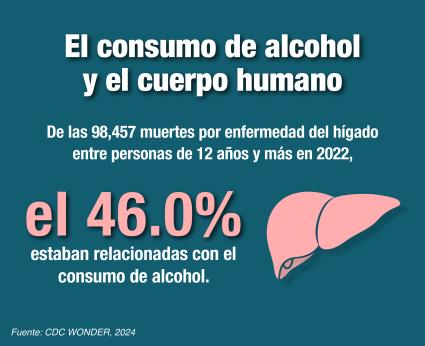El alcohol y el cuerpo humano
Image

- De las 98,457 muertes por enfermedad del hígado entre personas de 12 años y más en 2022, el 46.0% involucró al alcohol. Entre los hombres, ocurrieron 60,412 muertes por enfermedad del hígado, con el 48.6% relacionadas con el alcohol. Entre las mujeres, ocurrieron 38,063 muertes por enfermedad del hígado, con el 41.8% relacionadas con el alcohol.1
- Entre todas las muertes por cirrosis en 2019, el 50.3% estaban relacionadas con el alcohol. El porcentaje de muertes por cirrosis asociadas con el consumo de alcohol fue más alto (el 80,9%) entre los adultos de 25 a 34 años, seguido por los adultos de 35 a 44 años (el 75,4%).2
- De 2010 a 2016, la enfermedad del hígado asociada con el alcohol fue la causa principal de casi 1 de cada 3 trasplantes de hígado en los Estados Unidos, reemplazando a la infección por el virus de la hepatitis C como la principal causa de trasplante de hígado debido a la enfermedad del hígado crónica.3,4
- Estimados recientes para los Estados Unidos indican que el 5.6% de los casos de cáncer y el 4.0% de las muertes por cáncer son atribuibles al consumo de alcohol.5
- La investigación ha demostrado que las personas que consumen indebidamente alcohol tienen un mayor riesgo de presentar enfermedad del hígado, enfermedad cardíaca, depresión, accidente cerebrovascular y sangrado estomacal, así como cáncer de cavidad oral, esófago, laringe, faringe, hígado, colon y recto.6-9 Estas personas también pueden tener problemas para controlar afecciones como la diabetes, la presión arterial alta, el dolor y los trastornos del sueño. El consumo indebido de alcohol también puede aumentar la probabilidad de comportamientos sexuales de riesgo.
- El consumo de alcohol se asocia con un mayor riesgo de ahogamiento y lesiones por violencia, caídas y colisiones automovilísticas.9-12 El consumo de alcohol también se asocia con un mayor riesgo de cáncer de mama femenino, cáncer de orofaringe, cáncer de esófago (especialmente en individuos que heredan una deficiencia en una enzima implicada en el metabolismo del alcohol) e interacciones dañinas con medicamentos.3,9,14-19 El consumo de alcohol se ha relacionado con el riesgo de trastornos del espectro alcohólico fetal en la descendencia de mujeres que consumen alcohol durante el embarazo.20

